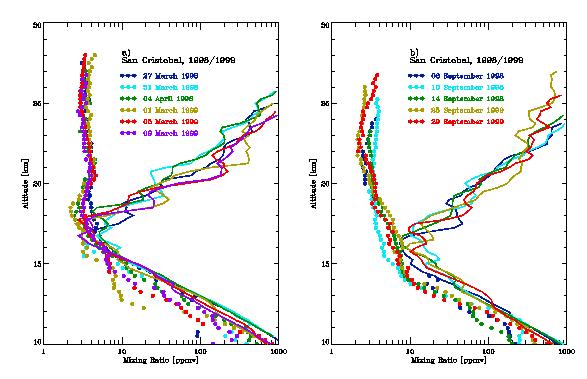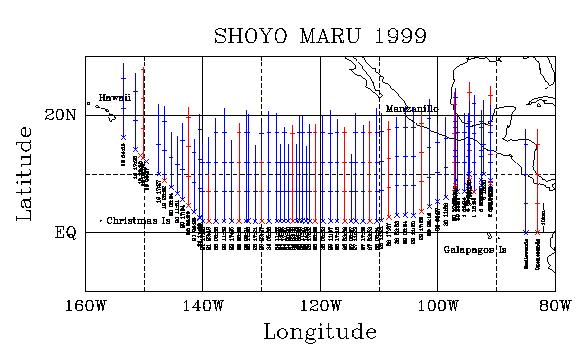Water vapor distribution around the tropical tropopause region
Our water vapor soundings have revealed for the first time the seasonal and regional characteristics of water vapor distributions in the tropical UT/LS region. Figure 2 shows examples of water vapor measurements at San Cristobal Island in the Galapagos Islands. In March-April, water vapor concentrations are low and nearly saturated around the tropopause, while in September the concentrations are high and often sub-saturated. (Vömel et al. (2002), Balloon-borne observations of water vapor and ozone in the tropical upper troposphere and lower stratosphere, JGR)

Figure 2. Water vapor soundings in the Galapagos. Dots are for water vapor mixing ratios, and curves are for saturation mixing ratios calculated from air temperature data. Left panel shows observations in March-April, and right panel shows those in September.
Water vapor control at the tropopause by equatorial Kelvin waves
Soundings in the Galapagos provided an observational evidence that the equatorial Kelvin wave, a large-scale disturbance, around the tropopause acts as a dehydration pump for the stratosphere. This process may be one of the important mechanisms that control the stratospheric water vapor concentrations, hence the stratospheric photochemistry.
(Fujiwara et al. (2001),
Water vapor control at the tropopause by the equatorial Kelvin wave observed over Galápagos,
GRL)
Ozone measurements in a ship cruise in the equatorial eastern Pacific
We carried out a ship cruise along the equatorial eastern Pacific where intensive ozonesonde and meteorological radiosonde soundings were made for the first time. We found layerings in tropospheric ozone which were often anti-correlated with humidity.
(Shiotani et al. (2002),
Ozonesonde observations in the equatorial Eastern Pacific - the Shoyo-maru survey -,
JMSJ;
Hashizume et al. (2002),
Direct observations of atmospheric boundary layer response to SST variations associated with Tropical Instability Waves over the eastern equatorial Pacific,
JCLI;
Fujiwara et al. (2003),
Upper-tropospheric inversion and easterly jet in the tropics,
JGR
)

Figure 3. Location and vertical extent of ozonesonde and radiosonde measurements from the research vessel Shoyo-maru in September-October 1999. See the right-hand side of the panel for the legend. Date and time (Universal Time) of the soundings are shown as "dd hh:mm" (day, hour, and minute).
Intercomparison of water vapor sensors in the tropics
We have been making several intercomparison campaigns of the three water vapor sensors as introduced previously. This is very important for the current scientific community because we now have no established water vapor sensors for monitoring the tropical UT/LS regions. We are focusing especially on the "Snow White" hygrometer for this purpose, and maintaining close relationship with the manufacturer in Switzerland to improve this sensor.
(Fujiwara et al. (2003),
Performance of the Meteolabor "Snow White" chilled-mirror hygrometer in the tropical troposphere: Comparisons with the Vaisala RS80 A/H-Humicap sensors,
JTECH
)
